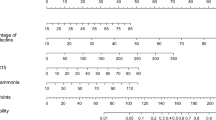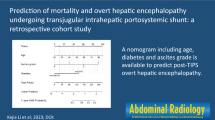Abstract
Background
We previously reported liver stiffness (LS) as a prognostic predictor of portosystemic shunt (PSS) occlusion. This study aims to reinvestigate the predictive factors of the model for end-stage liver disease-sodium (MELD-Na) score amelioration following balloon-occluded retrograde transvenous obliteration (BRTO) and to evaluate the postoperative prognoses of patients with portal hypertension by using newly identified factors.
Methods
Seventy-five patients who underwent BRTO between 2008 and 2021 were retrospectively enrolled. The MELD-Na scores were calculated preoperatively and one month postoperatively. We monitored long-term outcomes and analyzed postoperative survival.
Results
At one month postoperatively, the MELD-Na score decreased in 46 (61.3%) patients. Univariate analyses revealed a significant association of the score amelioration with nine factors, including lower LS levels and a higher international normalized ratio (INR). A multivariate logistic regression analysis with receiver operating characteristic curve analyses identified preoperative LS levels and INR as significant independent predictors of the postoperative MELD-Na score amelioration, with optimal cutoffs of 28.1 kPa and 1.06, respectively. The combination of LS < 28.1 kPa and INR ≥ 1.06 showed a sensitivity and specificity of 84.8% and 75.9% for the prediction of the score amelioration, respectively. For the propensity score model, we matched 24 patients with similar age, sex, MELD-Na score, and concomitant hepatocellular carcinoma. Kaplan–Meier analysis determined significantly higher cumulative survival rates in patients with LS < 28.1 kPa and INR ≥ 1.06 than in other populations.
Conclusions
A combination of LS and INR can predict the MELD-Na score amelioration and prognosis improvement following PSS occlusion.



Similar content being viewed by others
Abbreviations
- BRTO:
-
Balloon-occluded retrograde transvenous obliteration
- INR:
-
International normalized ratio
- LS:
-
Liver stiffness
- MELD-Na:
-
Model for end-stage liver disease-sodium
- PSS:
-
Portosystemic shunt
References
Kanagawa H, Mima S, Kouyama H, et al. Treatment of gastric fundal varices by balloon-occluded retrograde transvenous obliteration. J Gastroenterol Hepatol. 1996;11:51–8.
Hirota S, Matsumoto S, Tomita M, et al. Retrograde transvenous obliteration of gastric varices. Radiology. 1999;211:349–56.
Fukuda T, Hirota S, Sugimura K. Long-term results of balloon-occluded retrograde transvenous obliteration for the treatment of gastric varices and hepatic encephalopathy. J Vasc Interv Radiol. 2001;12:327–36.
Akahane T, Iwasaki T, Kobayashi N, et al. Changes in liver function parameters after occlusion of gastrorenal shunts with balloon-occluded retrograde transvenous obliteration. Am J Gastroenterol. 1997;92:1026–30.
Hirota S, Kobayashi K, Maeda H, et al. Balloon-occluded retrograde transvenous obliteration for portal hypertension. Radiat Med. 2006;24:315–20.
Kumamoto M, Toyonaga A, Inoue H, et al. Long-term results of balloon-occluded retrograde transvenous obliteration for gastric fundal varices: hepatic deterioration links to portosystemic shunt syndrome. J Gastroenterol Hepatol. 2010;25:1129–35.
Naeshiro N, Aikata H, Kakizawa H, et al. Long-term outcome of patients with gastric varices treated by balloon-occluded retrograde transvenous obliteration. J Gastroenterol Hepatol. 2014;29:1035–42.
Imai Y, Nakazawa M, Ando S, et al. Long-term outcome of 154 patients receiving balloon-occluded retrograde transvenous obliteration for gastric fundal varices. J Gastroenterol Hepatol. 2016;31:1844–50.
Yamamoto A, Nishida N, Morikawa H, et al. Prediction for improvement of liver function after balloon-occluded retrograde transvenous obliteration for gastric varices to manage portosystemic shunt syndrome. J Vasc Interv Radiol. 2016;27:1160–7.
Ishikawa T, Sasaki R, Nishimura T, et al. Liver stiffness measured by transient elastography as predictor of prognoses following portosystemic shunt occlusion. J Gastroenterol Hepatol. 2019;34:215–23.
de Franchis R, Bosch J, Garcia-Tsao G, et al. Baveno VII—renewing consensus in portal hypertension. J Hepatol. 2022;76:959–74.
Ishikawa T, Shiratsuki S, Matsuda T, et al. Occlusion of portosystemic shunts improves hyperinsulinemia due to insulin resistance in cirrhotic patients with portal hypertension. J Gastroenterol. 2014;49:1333–41.
Ishikawa T, Aibe Y, Matsuda T, et al. Plasma glucose level is predictive of serum ammonia level after retrograde occlusion of portosystemic shunts. AJR Am J Roentgenol. 2017;209:W169–76.
Ishikawa T, Sasaki R, Nishimura T, et al. Comparison of patients with hepatic encephalopathy and those with gastric varices before and after balloon-occluded retrograde transvenous obliteration. Hepatol Res. 2018;48:1020–30.
Ishikawa T, Sasaki R, Nishimura T, et al. Splenic non-infarction volume determines a clinically significant hepatic venous pressure gradient response to partial splenic embolization in patients with cirrhosis and hypersplenism. J Gastroenterol. 2021;56:382–94.
Yeh WC, Li PC, Jeng YM, et al. Elastic modulus measurements of human liver and correlation with pathology. Ultrasound Med Biol. 2002;28:467–74.
The Liver Cancer Study Group of Japan. The general rules for the clinical and pathological study of primary liver cancer. 6th ed. Tokyo: Kanehara; 2015.
Kudo M, Kitano M, Sakurai T, et al. General rules for the clinical and pathological study of primary liver cancer, nationwide follow-up survey and clinical practice guidelines: the outstanding achievements of the liver cancer study group of Japan. Dig Dis. 2015;33:765–70.
Garcia-Tsao G, Groszmann RJ, Fisher RL, et al. Portal pressure, presence of gastroesophageal varices and variceal bleeding. Hepatology. 1985;5:419–24.
Ripoll C, Groszmann R, Garcia-Tsao G, et al. Portal hypertension collaborative group. Hepatic venous pressure gradient predicts clinical decompensation in patients with compensated cirrhosis. Gastroenterology. 2007;133:481–8.
Ripoll C, Groszmann RJ, Garcia-Tsao G, et al. Hepatic venous pressure gradient predicts development of hepatocellular carcinoma independently of severity of cirrhosis. J Hepatol. 2009;50:923–8.
de Franchis R. Expanding consensus in portal hypertension: report of the Baveno VI consensus workshop: stratifying risk and individualizing care for portal hypertension. J Hepatol. 2015;63:743–52.
Bosch J, Abraldes JG, Berzigotti A, et al. The clinical use of HVPG measurements in chronic liver disease. Nat Rev Gastroenterol Hepatol. 2009;6:573–82.
Vizzutti F, Arena U, Romanelli RG, et al. Liver stiffness measurement predicts severe portal hypertension in patients with HCV-related cirrhosis. Hepatology. 2007;45:1290–7.
Saad WE. Portosystemic shunt syndrome and endovascular management of hepatic encephalopathy. Semin Intervent Radiol. 2014;31:262–5.
Ishikawa T, Sasaki R, Nishimura T, et al. Improved hepatic reserve and fibrosis in a case of “portal-systemic liver failure” by portosystemic shunt occlusion. Am J Case Rep. 2020;21: e921236.
Wood AJ, Villeneuve JP, Branch RA, et al. Intact hepatocyte theory of impaired drug metabolism in experimental cirrhosis in the rat. Gastroenterology. 1979;76:1358–62.
Kawasaki S, Imamura H, Bandai Y, et al. Direct evidence for the intact hepatocyte theory in patients with liver cirrhosis. Gastroenterology. 1992;102:1351–5.
Acknowledgements
We would like to thank Editage (www.editage.jp) for the English language editing.
Funding
Our work was partially supported by Gilead Sciences, Inc. and a Grant-in-Aid for Research on Hepatitis from the Ministry of Health Labor and Welfare of Japan and the Japan Agency for Medical Research and Development (JP22fk0210113).
Author information
Authors and Affiliations
Contributions
Conceptualization: TI. Methodology: TI. Data collection: TI, ME, TF, NN, DK, RS, TN, NT, TO, IS. Formal analysis and investigation: TI. Writing-original draft preparation: TI. Writing-review and editing: RS, TN, TT. Supervision: TT.
Corresponding author
Ethics declarations
Conflict of interest
The authors declare that they have no conflicts of interest concerning this article.
Ethical approval
The research performed was in accordance with the Declaration of Helsinki and was approved by our hospital’s institutional review board (2022–092).
Additional information
Publisher's Note
Springer Nature remains neutral with regard to jurisdictional claims in published maps and institutional affiliations.
Supplementary Information
Below is the link to the electronic supplementary material.
535_2022_1947_MOESM1_ESM.tif
Supplementary file1 Supplemental Fig. E1. Correlation between preoperative LS levels and INR among the 75 enrolled patients. There is a significant positive correlation between preoperative LS levels and INR (r = 0.2757, P = 0.0166). In total, 46 (61.3%) patients fulfilled the criteria with both LS < 28.1 kPa and INR ≥ 1.06 (black enclosure). r means correlation coefficient. LS, liver stiffness; INR, international normalized ratio. (TIF 77 KB)
Rights and permissions
Springer Nature or its licensor (e.g. a society or other partner) holds exclusive rights to this article under a publishing agreement with the author(s) or other rightsholder(s); author self-archiving of the accepted manuscript version of this article is solely governed by the terms of such publishing agreement and applicable law.
About this article
Cite this article
Ishikawa, T., Egusa, M., Fujioka, T. et al. A combination of liver stiffness and international normalized ratio is an ideal prognostic predictor of portosystemic shunt occlusion in patients with portal hypertension. J Gastroenterol 58, 246–256 (2023). https://doi.org/10.1007/s00535-022-01947-8
Received:
Accepted:
Published:
Issue Date:
DOI: https://doi.org/10.1007/s00535-022-01947-8




